+44 75754 30035 help@rapidassignmenthelp.co.uk
offer
🎄🎁✨ Christmas Special 🎄🎁✨ Discounts - Up to 55% OFF!
🎊✨ New Year Special ✨🎊 Discounts - Up to 55% OFF!
Remote health and wellbeing monitoring systems have become increasingly vital in today’s healthcare landscape, as they enable the continuous tracking of patient data outside traditional clinical environments. The Securing Remote Health and Wellbeing Monitoring Assignment Sample investigates innovative security frameworks, integrating Hyperledger Fabric blockchain and SD-WAN technology to address common challenges like data privacy, cybersecurity, and system scalability. By leveraging these advanced technologies, the assignment aims to safeguard patient information, comply with regulatory requirements, and foster greater confidence in remote telemedicine solutions. For students and professionals eager to grasp these complex technological concepts, assignment help online provides accessible guidance and expert support, ensuring strong academic performance and practical understanding of secure remote monitoring systems.
The aim of this research is to establish a framework of security for Remote Health and Wellbeing Monitoring Systems (RHMS) adopting trending technologies such as SD-WAN and Hyperledger fabric models. This framework shall improve the privacy of personally identifiable information data, UK regulations, and the overall minimization of cybersecurity risks that shape the confidence towards telemedicine service provision.
Patient care will be highly enhanced due to evolutionary remote health monitoring systems comprising various Internet of Medical Things-based devices. However, these systems bring up issues in terms of security, scalability and better management of the data. The available frameworks, such as the IEEE 11073 framework and HL7 FHIR, face challenges related to fragmented guidelines (Setyawan et al 2021). These challenges make implementation across different levels of interconnectivity such as device-to-device, system-to-system, and cloud integration complex and resource-intensive, though not impossible. Efforts to address these gaps often require significant customization and alignment with specific use cases. Technologies like blockchain, Software-Defined Wide Area Network (SD-WAN) have also shown potential to fulfill the above requirements (Kovacs et al., 2024). Blockchain, specifically Hyperledger Fabric ensures Decentralised Storage, data Consensus and immutability with high security levels. At the same time, the architectures of SD-WAN make networks easily scalable, while ensuring data is transmitted securely with centralized management.
This dissertation incorporates a number of sophisticated ideas to tackle the security and the scalability issues of the remote health monitoring systems. Hyperledger Fabric v2.5 is chosen as the base blockchain architecture because of its modular design, which provides a high level of safety for data exchange and establishes transparency and resistance to changes beyond doubt. In addition, the SD-WAN framework is also applied for routing, redundancy and encryption to enable safe data transfer in distributed healthcare networks (Zohaib et al., 2024). For the enhanced control, RBAC provides an opportunity to set detailed permissions and protected health information. Furthermore, the integration of the Zero-Trust Security Architecture with continuous evaluation and authentication offers for access requests a secure and compliant function for healthcare across the board.
Several rigorous research studies have provided evidence that Hyperledger Fabric can be employed as a reasonable foundation for securely processing EHRs in environments supported by IoMT systems. Decentralization, immutability and smart contracts in Hyperledger Fabric are quite effective for the identification of entities and the secrecy of data. These features solve several problems in the field of handling health care data like securing the patients’ data, providing adequate audited trails, and making sure that the data protection regulation complies with the GDPR. According to other researches, this Hyperledger in fact allows for secure, for exchange of data between different providers of healthcare services without compromising the privacy and integrity of personal data thus gaining access to the necessary data in patient records without violating (Narouwa et al., 2024). However, there are some drawbacks in scalability and performance optimization which has to be improved for real-time health monitor system to provide low latency and high throughput. In the same way, SD-WAN technology has been implemented within the enterprise context to optimize the networks performance and security. These factors of centralized control, traffic prioritization, and multi-link redundancy enhance the dynamism of a network since it is always in a position to connect and offer data transfer at the right time without interruption, but this makes the adoption of a sophisticated system in healthcare systems less researched for. SD-WAN will make the communication among remote sites of hospitals, clinics, and care homes secure while having encrypted tunnels along with a mechanism of failover. A complete framework can be generated using SD-WAN combined with Hyperledger Fabric in order to achieve the unique challenges of remote health monitoring - data security, network resilience, and scalable connectivity.
Despite the tremendous development, remote health monitoring systems still have critical challenges that limit their effectiveness. One of these is security vulnerability, as cyberattacks on health data have increased by 22% year over year in the UK, indicating weaknesses in the current frameworks. These breaches expose patient privacy and reduce the trust that patients have in telemedicine services. The other problem of scalability limitations within the legacy systems hinders the ever-increasing health data volume resulting from the output of current IoMT devices from being able to handle performance bottlenecks and inefficiency. Data management challenges add to that, as the integrity, access control, and conformity with regulations, such as GDPR and the Data Protection Act 2018, mandate powerful frameworks for meeting more stringent standards (Tahir et al., 2020). In order to address these challenges, this paper proposes a single Combined Solution with Hyperledger Fabric Bockchain Protocol and SD-WAN Architecture. It is important in today’s world to achieve solid data security, that will allow using the results of monitoring for development of effective health strategies on the base of organizational and informatics technologies with higher flexibility and manageability.
Several contributions will be made in this report for improving the security, scalability, and reliability of remote health monitoring systems. The purpose is the development of secure and scalable framework that should use blockchain-based data management on top of Hyperledger Fabric for tamper-proof storage and transparent data transactions to maintain protection of health-related data from unauthorized modifications as well as breaches through applying the properties of immutability by blockchain. In addition, the SD-WAN architecture has introduced resilient network connectivity with multi-link redundancy, traffic prioritization, and centralized management, ensuring communication and performance across distributed health sites without any disruptions (Figueroa-Lorenzo, 2021). To further enhance data privacy and security, this framework includes role-based access control to provide granular access permission that allows data access by authorized personnel alone. Expected gains include data security through Blockchain, network reliability through SD WAN, and better compliance to legal requirements, for example, GDPR. Enhancement of these aspects will help develop trust in telemedicine services which in turn leads to its increased usage while adopting safer and reliable remote healthcare solution.
In order to make the requirements legal this project emphasizes data protection and information confidentiality and legal compliancy in respect of sensitive health information and GDPR in combination with the Data protection act of 2018. Features include pseudonymization and encryption of data to ensure patients’ identification is not revealed while enabling data to retain its usability for analyses and real-time monitoring. This approach ensures that healthcare providers can still associate data with individuals during active monitoring. Additionally, Role-Based Access Control is utilized to restrict access to sensitive data, ensuring that only authorized personnel can access it. This prevents unauthorized breaches and maintains confidentiality. Ethical compliance forms the backbone of the study, with all activities approved by Institutional Ethical Review Boards. Furthermore, ethical safeguards against non-discrimination and unfair practices in SD-WAN and Hyperledger Fabric models are integrated into the system (Vilalta, 2021). Safety measures include the use of IPSec encryption within SD-WAN frameworks for secure data transfers and a blockchain-based audit environment. Finally, simulations are conducted prior to deployment to ensure risk-free experiments and verify system reliability.
Subsequent chapters of this dissertation outline a thorough evaluation of the proposed framework. The Literature Review assesses the available approaches, pinpoints the issues and relevant technologies for the remote health monitoring systems that focus on security, scalability, and solutions related to data management. Methodology presents the details regarding the design and implementation of the framework that is emphasizing Hyperledger Fabric blockchain with the architecture of SD-WAN that leads to creating a system of a secure and scalable one. The chapter, Results and Evaluation, evaluates the performance of the proposed solution with predefined metrics to measure the effectiveness of the proposed solution in improving data security, network resilience, and regulatory compliance. Finally, Conclusion and Future Work presents the main findings, outlines contributions, and proposes ways for further improvement, such as scalability and performance optimization.
Remote health monitoring systems have come up as a revolution in patient care by using sophisticated technologies such as Internet of Medical Things and blockchain systems in their operations. Despite this, the pervasive vulnerabilities of security, data breaches, and scalability have not promoted its widespread use. For instance, frameworks like IEEE 11073 and HL7 FHIR are un-uniformly standardized, posing an integration complexity. The literature emphasizes blockchain, in the form of Hyperledger Fabric, as a promising candidate because of its decentralization, immutability, and cryptographic mechanisms towards data security and transparency, while SD-WAN assures scalability and network resilience, thus ensuring secure data transmission. Therefore, a combination of two of these mentioned technologies solves the two biggest problems of data privacy and data integrity as well as scalability challenges. This chapter provides a brief account of the latest developments in securing RHMS through the application of block chain protocols, cryptographic techniques, network architectures and their impact and shortcomings.
Enhancing Medical Record Security and Transparency with Blockchain Technology in Health Information Systems
According to Balachandran et al., 2020, the proposed system is expected to enhance medical records' security, transparency, and integrity through the exploitation of blockchain technology in a health information system. Based on the 3-tier architecture, the client side, an application server, and blockchain database will play different roles in ensuring data security and accessibility. The heart of the system consists of a decentralized blockchain, to which medical records are maintained and authenticated. The blockchain network runs through peer-to-peer nodes and no single node is able to manipulate data, ensuring no one tampers or changes it in any form (Secure Health Information System with Blockchain Technology, 2023). The system relies on cryptographic techniques where a hash value is assigned to every medical record. This hash is the output generated with fixed length from input data. In case the record is altered, it changes its hash, and this could indicate tampering. This mechanism provides an almost complete level of security, because any change made to the record is readily detectable. The 3-tier architecture in the system features a client-side, the application server, and blockchain database. It makes the client side user-friendly as that is entailed to allow any patient together with his or her healthcare worker to interface and gain access to the system. It is designed with HTML, CSS, JavaScript which in turn has a simple and user-friendly login, read medical records and many more. That means the application server is the business logic layer that includes data processing, operation management, and the interaction with blockchain network. It uses Node.js, Composer and Docker. The last layer is referred to as the blockchain database that has a distributed ledger network for storage of the medical records. This tier ensures the issue of medical record security and openness using Ganache, Yarn and Truffle. This allows the health personnel to post the encrypted medical results to the block chain so that these are shared within the network and validated and agreed on by the consensus.
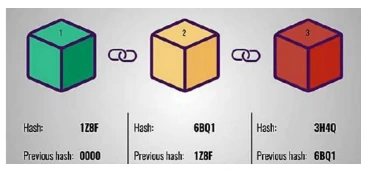
Figure 1: Blockchain overview
The patients and the health personnel will have to login using their credentials in order to get access the portal. Health personnel after signing up can be able to upload the medical results on the blockchain while the patient shall be able to see the records. Patients may also make the request for changes to their personal information which go through a block chain approval of other participants in the network to ensure that no one makes any change behind the patients back (Abd Elkareem et al., 2024). This distributed approach to data handling also avoids the requirement for a centralized administrator and makes alterations to records of the medical nature to be substantiated by consensus with the members of the network. During the experimentation phase, the health records needed to be encrypted, along with additional hash values for data integrity (Honar Pajooh et al., 2021). Files were transferred in the peer to peer model with all the transaction made visible to all the participants. The system was tested to scale and is evident that with more nodes, decentralization and security of the blockchain network is guaranteed.
Get assistance from our PROFESSIONAL ASSIGNMENT WRITERS to receive 100% assured AI-free and high-quality documents on time, ensuring an A+ grade in all subjects.

Figure 2: Blockchain-Based Secure Health Information System
Sec-Health: A Blockchain-Based Protocol for Secure and Privacy-Preserving Health Record Management
According to Costa et al. 2023, the proposed Sec-Health protocol that uses the blockchain will address major issues of storage, sharing and management of EHRs meeting stringent regulatory requirement including data protection and integrity issues such as confidentiality, access control, and emergency access. This is intended to overcome the constraints of the currently existing systems where their operations rely on a central server or lack adequate security attributes. However, Sec-Health uses cryptographic techniques to propose a decentralized platform for the handling of individuals’ health information where various parties, all of which have different functions, are involved in the protocol including healthcare workers (collaborators), consumers, researchers, emergency servers, and careers. All participants are considered secure, hardware is expected to be secure and the communication lines as secured by good protocols such as secure hypertext transfer protocol. It incorporates all risks resulting from unauthorized access and data modification as well as access after its revocation. The last but the most significant feature of the Sec-Health is because it is able to update or delete the health record quickly and easily without compromising the Health record’s integrity and the information within it. The protocol is segmented into the Setup Phase, the Storage Phase, the Sharing Phase and the Emergency Access Phase in case of untimely death. During this phase of the setup phase, the necessary of the whole setting, as well as the chain of block are also established whereas the participants are identified. It involves making of cryptographic key pairs, and distribution of CP-ABE keys to the participants from the authority. The network is utilized for the decentralized storage of health records, while metadata is safely stored on the blockchain to provide transparency, making sure that the health records are immutable (Seo et al., 2024). Emergency servers also have to be configured in the registration process. This setup is very crucial in the Emergency Access phase.
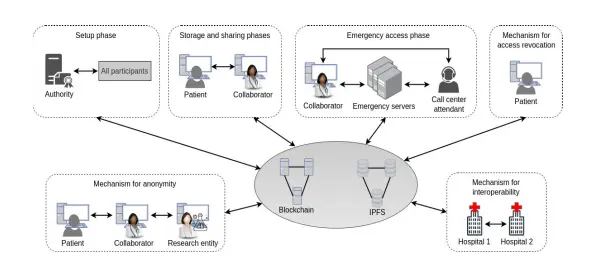
Figure 3: Overview of Sec-Health with its phases
The Storage stage takes up the creation of health records by collaborators, who use CP-ABE for the record encryption. They append it with metadata, which includes a hash of the record to verify data integrity while serving the purpose of safe links that point to health encrypted. The Sharing phase allows only collaborating, authorized users to have access to the health records through blockchain retrieval of metadata decryption of it and then the record retrieval from encrypted. Access is given due to the cryptographic material issued during the setup phase and in such a way that ensures that only authorized participant’s access sensitive data. The Emergency Access phase is meant to provide for access to health records when a patient cannot give permission, in an emergency. In such a case, the metadata of the patient's health record is encrypted using the public keys of emergency servers, and thus only those authorized to do so shall access the health records (Sosnowski et al., 2023). It is a collaborative process between the attendants, emergency servers, and healthcare professionals in decrypting and retrieving the health records. This phase ensures that patient’s privacy is respected although access can be granted wherever it is beneficial. By use of blockchain, transparency is must since a patient can verify different emergency access sessions using the correlated transaction record.
Listing of patient authorization, the termination of patient access, and excluding the patient’s identification for analysis purposes are among the main benefits of Sec-Health. Access to health records can be revoked at any point, and this revocation can be recorded on the blockchain with much ease, and hence there is no need to re-encrypt the data (Ajithraj and Rajagopalan, 2024). For the purpose of research, health records can be shared without revealing the identity of the patient, which guarantees anonymity through a proof mechanism and blockchain transactions. It improves the efficiency and security of the healthcare systems by facilitating data exchange seamlessly between health organizations through its interoperability feature. Even with so many advantages, the main challenges that Sec-Health poses relate to storage overhead and security at blockchain nodes. For instance, for each collaborator, multiple copies of the health records may need to be stored, which might result in increased storage requirements. Moreover, if compromised, the blockchain nodes can potentially let malicious nodes return the deleted or revoked records however, the system is distributed in nature and transparent enough to mitigate these risks partially. Further future work will probably center around overcoming these limitations in a quest for increased efficiency and security.
Blockchain-Enabled IoT Platform for Secure and Scalable E-Health Data Management
According to Ktari et al., 2022, to combine the blockchain technology with Internet of Medical Things (IoMT) in order to promote security and privacy in the EHR. By incorporating smart sensors, for instance, for blood pressure, SPO2, and EEG, the proposed system gathers health data, encrypts them, and places them in a secure manner within the blockchain. The system is relayed through a Raspberry Pi 4 platform to collect the data, process it, and save it on an embedded blockchain node. Preliminary results suggest that the cost of such a system will be reasonable for securing EHR management. Benefits about blockchain including openness, security, disintermediation, and autonomy the paper starts with outlining of the benefits of Blockchain like transparency, security, autonomy, and disintermediation. It reviews the diverse applications of blockchain types including data transfer and securing sensitive information related to medical research. The role of blockchain technology, hence, is highlighted, emphasizing the importance of solving medical data fragmentation and the potential of making patient data remain immutable, private, and transparent. This integration of Blockchain with IoT devices in the healthcare sector has been discussed, emphasizing real-time monitoring of patients and secure storage of data. However, the system has challenges in terms of hardware requirements, particularly in embedded systems such as Raspberry Pi and FPGA, in managing the consensus mechanism. Still, the decentralized nature of Blockchain presents a strong solution to the management of secure health data. Furthermore, this calls for more significant cooperation between healthcare organizations, and Blockchain can save a lot of money by giving enhanced data security and confidentiality (Salazar-Chacón, 2022). Smart contracts are designed to automate processes hence only authorized personnel can access certain records of patients, thereby improving trust and security. In this regard, discussions also relate to challenges in the performance of the Blockchain systems related to scalability and real-time data processing, especially where consensus mechanisms such as PoW have been applied (Zohaib et al., 2024). This proposed system leverages data that might be collected via wearable devices like EEG headsets, ECG sensors, as well as SPO2 monitors. It communicates data to a Raspberry Pi which is one of the data collection nodes. This Raspberry Pi 4 acquires and stores the data from individual regions in a local database using a web interface for retrieval. Collected data is encrypted and stored with its transaction in a Blockchain system for security reasons. The system interconnect with hospital, pharmacy and insurance company to detect and avoid any kind of fraud that may involve medical business transactions.
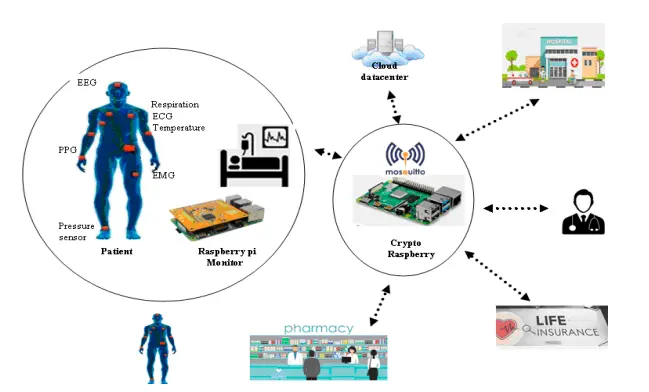
Figure 4: Embedded platform for the collection, use and management of medical and pharmaceutical data
A simple Proof of concept (PoC) is also envisioned for supporting wearable accessories, including bracelets, wristbands, EEG headsets, and others. The information is then transferred to Raspberry Pi 4 via Bluetooth or Wi-Fi where it is received, processed and forwarded to a Blockchain for storage. For security and confidentiality of the data the permissioned Ethereum Blockchain and PoW consensus algorithm are used. Computer Arithmetic FPGA technology is also utilized for enhancing the speed of the encryption process (Rahman et al., 2023). The system is composed of two layers of protection: data encryption in blockchain transactions and a PoW check on all possible alterations. It uses custom encryption IPs, which makes data difficult to decrypt. The system is decentralized, and so it ensures patient data privacy with flexibility for monitoring. It supports scalability and, thus, is suitable for small patient groups. The hardware implementation makes use of different components like smartwatches, mobile phones, Raspberry Pi, and FPGA boards. It uses FPGA to accelerate the Keccak algorithm in managing Ethereum's PoW consensus this system is energy-efficient as it reduces power consumption in contrast to traditional PC-based mining (Salazar Chacón, 2021). A blockchain-based application is developed using Ethereum. It uses Solidity for smart contracts and tools such as Truffle and Ganache for testing and deploying contracts.
Revolutionizing Healthcare: The Impact and Challenges of Blockchain Technology in Biomedical Applications
According to Kuo et al., 2017, blockchain technology has tremendous potential to impact the biomedical and health sectors. It offers a wide variety of benefits that could transform the management of data, maintain privacy, and enhance the efficiency of operations. This is through decentralization where patients have control over their healthcare records. This allows patients to manage and share health data directly with healthcare providers without centralized institutions. This benefits patients by enhancing the record availability and shortens record transfer between caregivers. Since audit trails imply that data in the blocks is immutable, this also implies that records themselves also cannot be changed or deleted once they are entered, thus adding to the general healthcare record credibility and genuineness. This is a very significant and irreversible feature since health care regulations are being enforced and fraudulent process in medical documentation are being prevented. This means that blockchain provides data origin as a feature of its functionality; for example, patients’ records can be digitally signed by the producer of the data so that its authenticity cannot be forged. This decentralization also enhances the ability of the technology to be strong, and be very much available, without any chances of losing such information or experiencing breach of data (Balachandran et al., 2020). The patient record is safe and accessible since the data isn’t stored under one source and therefore cannot be hacked or corrupted. What’s more, blockchain encrypts information and uses private key to secure data and anyone outside the loop cannot tamper with patient data, which is so relevant today given HIPAA regulations on patient data protection.
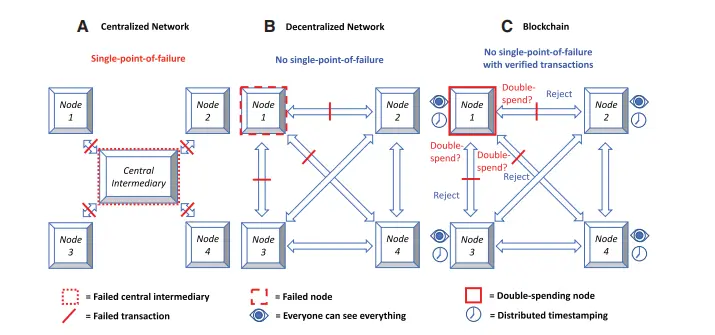
Figure 5: Comparison of Distributed Network Topologies: Centralized, Decentralized, and Blockchain
Blockchain technology can be introduced fully in the health care sector and has been described as enhancing change across a number of domains. Mobile health application based solutions are proposed for architectures involving medical record management where the patient owns and controls their health data through blockchain. Initiatives like MedVault and Gem Health Network are streamlining the sharing of medical records across healthcare providers while enhancing access and ensuring control by patients over their personal health information (Lembke et al., 2022). In the insurance industry, blockchain technology has streamlined the claims process with real-time adjudication and reduced the number of middlemen required. The technology is also transparent and non-repudiable and helps in preventing fraud while ensuring accuracy in claims by the insurer and the patient. Blockchain in clinical and biomedical research speeds up further advancements in the field as data can be shared across institutions in a secure and decentralized manner (Paillissé Vilanova, 2021). For example, research platforms like MedRec allow for efficient clinical data sharing, which supports the speed of breakthrough and improves the quality of biomedical research. Blockchain can offer secure data ledgers, from genomic information to the data of clinical trials as well as pharmaceutical supply chain, with traceability and transparency improving both research and the quality of patient care.
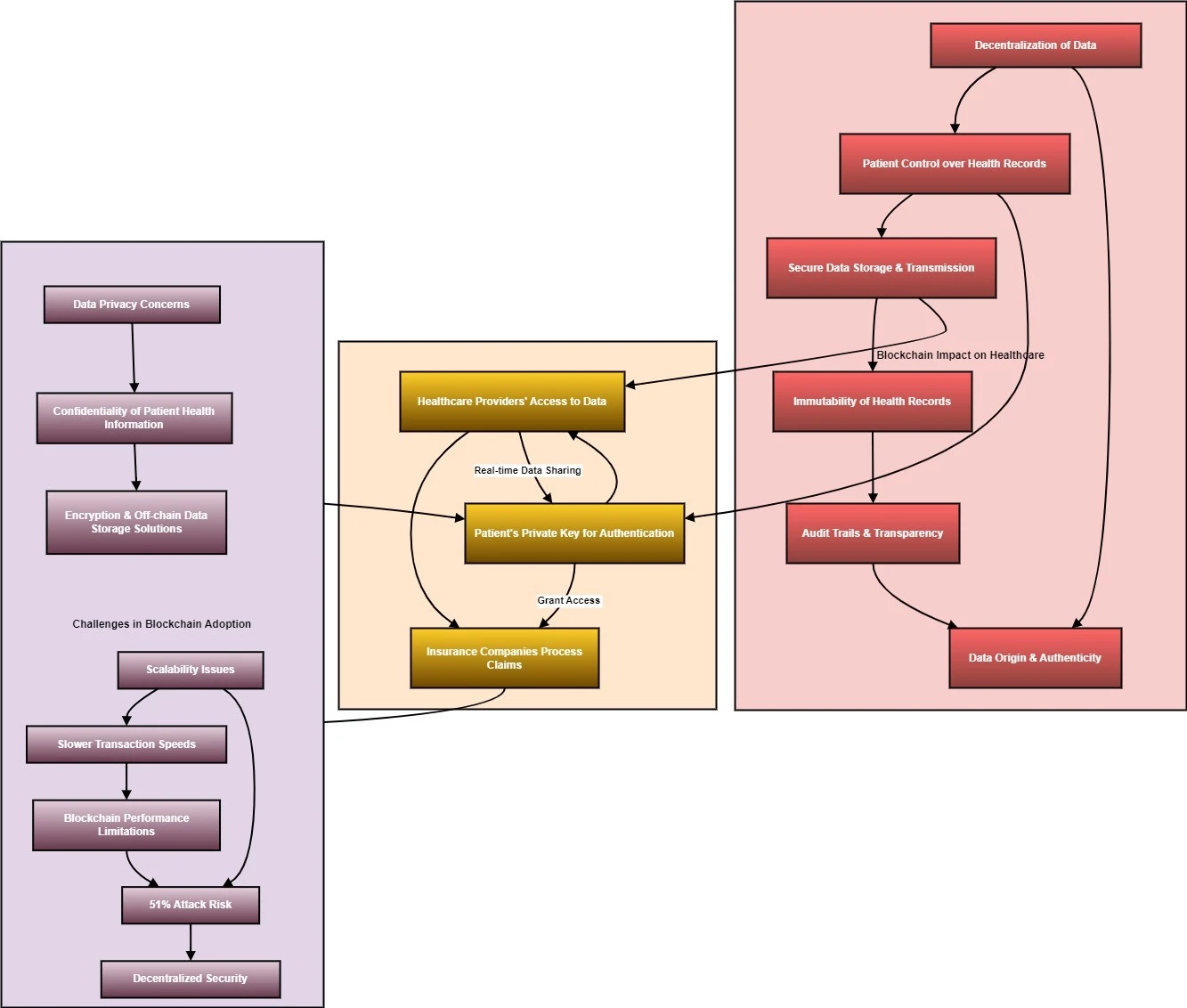
Figure 6: Blockchain's Impact in Biomedical Applications
However, it is by no means smooth falling into the adoption of blockchain in health care. For instance, while transparency may be needed in many places, sometimes it can compromise patient data due to the inclusion of confidential information, especially where PHI has been used. This could be tackled by encrypting sensitive data or by storing on an off-chain mechanism, holding only encrypted pointers on blockchain (Rafiee and Hupel, 2024). Another problem is about the speed and scalability issues of blockchain. For now, the speed of transaction for most blockchain networks is significantly slower than for traditional systems. This can be an obstacle for applying blockchain to real-time health care. A new generation of blockchain software is being designed to deal with these issues BigchainDB, for example, is engineered for greater speeds in transaction and better scalability. One more problem blockchain networks suffer from is so-called 51% attack, wherein the attackers control the network's majority in terms of its computational power. This can be minimized through the utilization of permissioned blockchain networks and private cloud environments, hence limiting unauthorized access and offering greater security.
The proposed system for improving the security of medical records by using the blockchain concept is more in line with concepts highlighted in the literature regarding the goals set for the application of the centralization of health data management. The artifact built on Hyperledger Fabric (HLF) v2.5 and SD-WAN system together covers multiple organizational types (hospital, GP, care home) and focuses on secure, identical data preservation similarly to the systems discussed in the papers under review.
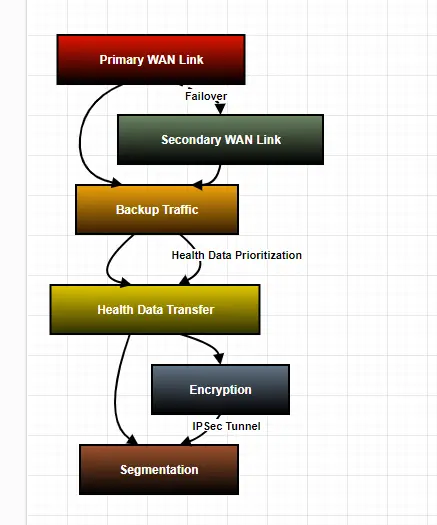
Figure 7: SD-WAN Multi-Link Redundancy
It become clear that the decentralised approach to blockchain for maintaining and securing potentially sensitive medial records and integrity of records in general is reflected directly in the artifact. For example, absence of central control and management system is underlined by the utilization of distributed ledger and peer to peer nodes; absence of data manipulation summarizes the use of the technology in healthcare setting. Furthermore, the use of cryptographic hashing in order to safeguard and make patients’ data integrity and accountability echoes the security features highlighted in the relevant literature. The integration of role-based access control (RBAC), which is yet to be developed, also enhances the aspect of the artifact in that only users possessing the right pedigree can access specific medical records in compliance with the privacy regulations. Hence, the artifact demonstrates an effective model in response to the major issues identified in the literature; it presents a large-scale, safe, and accountable system for managing medical data.
Significance blockchain applications in healthcare have depicted major breakthroughs in aspects of data security, transparence, and confidentiality. However, several key gaps remain in the current literature. Although, with the help of the technological options of blockchain in general and Hyperledger Fabric in particular, and SD-WAN architectures, data security, transparency, and scalability have been demonstrated to be significantly improved in healthcare, several gaps have emerged. Current solutions are not tailored to monitor static data about patients; they do not address the integration of the everyday health monitoring systems with wearables and IoT platforms. These are unique data that are very dynamic hence challenging in terms of real-time processing and security (Ktari et al., 2022). Moreover, sufficient proportional, optimized algorithms and processes for managing millions of records of human health data are insufficient, as is the storage requirement and computational complexity. Smart contract execution speed and the ability of blockchains to handle large volumes of data are crucial problems, and more so when it comes to making quick references to data in the context of healthcare delivery (Costa et al., 2023). As with many decentralization schemes, it brings reliability gains, and related threats include node and data unavailability upon failures. The key issue which has not yet been solved is the ability to interface with existing health IT systems, which requires secure and compliant integration solutions. However, one of the important requirements that may go unnoticed is the Complexity of Roles, especially the adaptation of Role-Based Access Control (RBAC) in blockchain-based healthcare systems (Kuo et al., 2017). Filling these gaps will improve reliability of remote health monitoring systems making them portable, secure and reliable to meet heath care standards.
2.5 Conclusion
The transformative use of blockchain and SD-WAN technologies solves key challenges in RHMS, that is, data immutability, transparency, and privacy through blockchain cryptographic techniques and decentralized frameworks ensure immutability. SD-WAN will allow scalable and resilient infrastructures for secure data transfer, and hence, it demonstrates potential frameworks like Sec-Health which make the health records to be managed using encryption and distributed storage. Despite all these developments, many issues persist, such as scalability, interoperability, and computational overheads in terms of encryption and consensus mechanism. The future research has to be conducted to optimize blockchain performance, deploy lightweight cryptographic methods, and achieve seamless interoperability with the current healthcare IT infrastructure. Additional features like AI/ML-based predictive threat detection and zero-trust security models will further enhance the protection level. By filling this gap, RHMS is able to provide scalable, secure, and compliant solutions and build trust in telemedicine and forward the future of remote healthcare systems.
In this chapter it significantly describes the research method used in this research to effectively implement the securing remote health and wellbeing monitoring. In order to enhance the research depth of the analysis, the research utilizes both quantitative and qualitative methods to meet the research objectives. The collection of primary data will be done using Tracer through SD-WAN in order to model and simulate the network and security aspects of the remote health monitoring systems while secondary data for other technological areas like encryption techniques will be collected from books, journals, articles and online resources. The approach utilized is both inductive and deductive since the pragmatic philosophy recognises both approaches for the significant discussion of the current research work.
This project incorporates a design based research approach by implementing and simulating a distributed immutable ledger over Hyperledger fabric with a secure SD-WAN architecture for disseminating the data efficiently. The methodology includes two separate, but complementary HLF and SD-WAN implementations that show how their benefits could be gained.
3.3.1 System Setup
The Hyperledger Fabric (HLF) setup has 3 organisations made up of their dedicated peer for Hospital, GP and Care Home. It’s a single channel through which data is flowing securely and seamlessly between organisations in an interconnected, streamlined way. There are three orderers providing consensus and Hyperledger Fabric integrity, and three MSPs (Membership Service Providers), managing identity and access control per organisation (Drabble et al.2021). Three CouchDB instances provide off chain data storage for fast and efficient management of non transactional data. Such configuration also provides the ability for collaborative healthcare management where each member in the organisation has access and exchange relevant information between each other in a distributed ledger environment.
3.3.2 Chaincode Development
The healthcare data is managed on the Hyperledger Fabric via the HealthMonitorContract chaincode, which can add, retrieve, all records, delete data by ID, and validate that some health data exists. The Membership Service Provider (MSP) offers security and authenticates and controls the access with proper authorization and only grants access to the authorised users. This ensures that healthcare information remains private, secure and protected, whilst supporting the exchange of clean and trusted healthcare information; between healthcare organizations with allowance for the strict control of access and data governance.
3.3.3 Data Handling
In this system data handling is to securely process healthcare data in privacy. To protect a sensitive information in both storage and transmission across the network, encrypting the health data using AES encryption. Furthermore, techniques for further pseudonymization are used to mask personally identifying information while maintaining patient anonymity, and allowing the data to be used for analysis. Health data are stored and retrieved by using the HealthMonitorContract chaincode on Hyperledger Fabric, and only authorised users are allowed to access or modify records. It also helps logically segments data to help ensure private health information is secured and signalled between trusted entities only.
Dual WAN links then ensure that the Hospital, GP and Care Home are connected with the SD-WAN solution, with at high availability and optimised routing. The architecture supports centralised management in vManage to enable policy configuration and monitoring, vSmart for excting routing policy enforcement and vBond for secure on boarding of the routers. Through on-demand traffic flow adjustments, prioritisation of critical healthcare data, and secure connexions between the organisations, this design improves network reliability, security, and optimises network performance (Kataria et al.2023). SD WAN solution enables flexibility, scalability and facilitates the management of networks in a simple way that ensures an uninterrupted communication in healthcare ecosystem.
Key features that SD-WAN solution offers includes multi-link redundancy, where it has dual WAN links at each site to provide failover facility. To verify network resilience, the iPerf tool is used to run failover and traffic conditions. Health data traffic optimization prioritises healthcare information above regular traffic using pre defined routing policies that guarantees the transmission of critical healthcare data in an efficient manner. Logical segmentation is ensured for privacy and security of health data, while encryption and segmentation are applied in IPSec tunnels for secure inter site communication. These features serve to make the SD-WAN solution suitable in healthcare environments where the need for continuous, secure data exchange creates a requirement for a more reliable, secure and high performing network.
A simulation of the SD-WAN network was performed through EVE-NG, using vEdge routers, vManage, vSmart, and vBond controllers for SD-WAN network management and routing. Local device connectivity were simulated through Cisco L2/L3 switches. Python scripts and CSV files were simulated replacing real world health data exchanges, creating a health data traffic. A setup such as this was used to test and validate the network performance, traffic optimization, and failover capabilities of the SD-WAN solution to prove that a secure and efficient means of transporting healthcare data exists between multiple sites in the simulation environment.
3.7.1 Current Status
Hardware constraints have led to the implementation of the HLF and SD-WAN systems as independent solutions. This data synchronisation between the two systems has not been performed to minimise the usage of resource. While each system works well in its assigned realm—HLF managing health care data and SD-WAN optimising network traffic—further integration between the two won’t happen soon (Chirra et al.2024). The approach enables each system to function efficiently without overloading available resources, which forms a good basis for integration and other tests when hardware capacity is available to run in tandem.
3.7.2 Testing
In the testing phase the HLF and SDWM systems performance and reliability are evaluated. Latency, throughput and encryption techniques are tested via key testing scenarios. iPerf is used to test network resilience in terms of failover through conditions which disrupt the traffic and validate SD-WAN performance. In addition, the HealthMonitorContract chaincode is tested for its ability to store and validate healthcare data on the Hyperledger Fabric blockchain. Both solutions, currently in use, work independently however it will be future tested for integration of both systems and measuring their combined efficiency in real world health environment.
Hardware constraints have led to the implementation of the HLF and SD-WAN systems as independent solutions. This data synchronisation between the two systems has not been performed to minimise the usage of resource. While each system works well in its assigned realm HLF managing health care data and SD-WAN optimising network traffic further integration between the two won’t happen soon. The approach enables each system to function efficiently without overloading available resources, which forms a good basis for integration and other tests when hardware capacity is available to run in tandem.
Due to time and skill limits, comprehensive front end interface is not implemented. Thus, using CouchDB’s localhost interface for basic (i.e. without advanced features like real time view and interactive elements) views of data. While this simple approach was able to quickly get the data tested and displayed without working end user functionality, it was lacking to serve as a user interface (Nascimento et al.2020). Coming forward, future enhancements will include a refined, GDPR compliant pseudonymization and a user friendly, lower friction, healthcare professional front-end.
The health data used was the researcher’s own data based on which the researcher didn’t have to worry about patient data of any other third party. The most effective of these approaches completely side stepped any ethical sentiments with regard to privacy and consent. On the security side, without compromising a physician's ability to work in their current environment, data Security was prioritised in exploring theoretically applying WARPG's like AES encryption and pseudonymization to protect sensitive health information through data sources found when searching on the web (Koutras et al.2020). The project sought to apply strong data protection standards using encrypted data and anonymisation methods. Going forward there will be more emphasis on the ethical considerations that must be followed to stick to GDPR, amongst other regulations for handling personal health data.
Futur work involves the seamless improvement in the efficiency and scalability across healthcare systems. BLE watch data will be sent directly to the HLF server for direct IoT integration which reduces latency. LoRaWAN devices will offer connectivity, especially in remote areas. This will integrate a group of hospitals, GPs and care homes together to try and improve data sharing and healthcare outcomes. Data communication and optimised routing will be fully integrated on the HLF and SD-WAN networks. This will result in a robust front end interface that will have real time fed data visualisation with improved security compliance for GDPR. Finally, HLF peers will help reduce latency and improve the bandwidth of an edge computing system resulting in better optimised bandwidth and latency.
3.12 Conclusion
In this research the framework of SD-WAN and Hyperledger fabric provides a systematic method of improving the security of RHMS with the cooperation of the zero-trust security model. Through integration of both qualitative and quantitative methods, and better approaches, the research seeks to develop a sound security framework to address modern day telemedicine challenges such as data protection and legalities. The research approach of using both primary and secondary data sources increases the reliability of the analysis of the technologies and the findings reflect the real-life application. The information emerging from the research delineated in the present analysis will be useful towards advance simulation and modeling, as well as to enhance security measures to minimize hazards and enhance the confidence in far distance health services. This research work will help the better evaluation of health monitoring that is secure, scalable, and compliant with standards and laws, like those in the United Kingdom.
Reference List
Journals
Introduction Don’t let assignments stress you out! Our Assignment Help Online services are here to provide...View and Download
Introduction Get free samples written by our Top-Notch subject experts for taking online Assignment...View and Download
Introduction: The Strategic Transformation of 7-Eleven Get free samples written by our Top-Notch subject experts for taking...View and Download
Introduction Get free samples written by our Top-Notch subject experts by choosing Online Assignment Help services. These...View and Download
Introduction: 5HR02 Strategic Talent & Workforce Planning Students can improve their understanding of workforce...View and Download
Introduction to Crime Among Young People In Wood Green Assignment A proper business strategy is very important to make a perfect...View and Download
